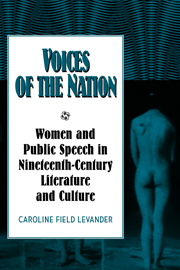Book contents
- Frontmatter
- Contents
- Acknowledgments
- Introduction: Gender, Speech, and Nineteenth-Century American Life
- 1 Bawdy Talk: The Politics of Women's Public Speech in Henry James's The Bostonians and Sarah J. Hale's The Lecturess
- 2 “Foul-Mouthed Women”: Disembodiment and Public Discourse in Herman Melville's Pierre and E. D. E. N. Southworth's The Fatal Marriage
- 3 Incarnate Words: Nativism, Nationalism, and the Female Body in Maria Monk's Awful Disclosures
- 4 Southern Oratory and the Slavery Debate in Caroline Lee Hentz's The Planter's Northern Bride and Harriet Jacobs's Incidents in the Life of a Slave Girl
- 5 Partners in Speech: Reforming Labor, Class, and the Working Woman's Body in Elizabeth Stuart Phelps's The Silent Partner
- 6 “Queer Trimmings”: Dressing, Cross-dressing, and Woman's Suffrage in Lillie Devereux Blake's Fettered for Life
- Conclusion: Women and Political Activism at the Turn into the Twentieth Century
- Notes
- Select Bibliography
- Index
- CAMBRIDGE STUDIES IN AMERICAN LITERATURE AND CULTURE
6 - “Queer Trimmings”: Dressing, Cross-dressing, and Woman's Suffrage in Lillie Devereux Blake's Fettered for Life
Published online by Cambridge University Press: 27 October 2009
- Frontmatter
- Contents
- Acknowledgments
- Introduction: Gender, Speech, and Nineteenth-Century American Life
- 1 Bawdy Talk: The Politics of Women's Public Speech in Henry James's The Bostonians and Sarah J. Hale's The Lecturess
- 2 “Foul-Mouthed Women”: Disembodiment and Public Discourse in Herman Melville's Pierre and E. D. E. N. Southworth's The Fatal Marriage
- 3 Incarnate Words: Nativism, Nationalism, and the Female Body in Maria Monk's Awful Disclosures
- 4 Southern Oratory and the Slavery Debate in Caroline Lee Hentz's The Planter's Northern Bride and Harriet Jacobs's Incidents in the Life of a Slave Girl
- 5 Partners in Speech: Reforming Labor, Class, and the Working Woman's Body in Elizabeth Stuart Phelps's The Silent Partner
- 6 “Queer Trimmings”: Dressing, Cross-dressing, and Woman's Suffrage in Lillie Devereux Blake's Fettered for Life
- Conclusion: Women and Political Activism at the Turn into the Twentieth Century
- Notes
- Select Bibliography
- Index
- CAMBRIDGE STUDIES IN AMERICAN LITERATURE AND CULTURE
Summary
[Women] find themselves voiceless in the making of the laws … having large interests at stake, they find their tongues tied and their hands fettered.
Mark Twain, Europe and Elsewhere (1873)In his sartorial history entitled The Psychology of Clothes (1930), J. C. Flugel states that traditionally “clothes reform tends to receive support from the generally rebellious, as a welcome symbolic expression of revolt.” Certainly woman suffrage advocates throughout the nineteenth century relied on the rhetoric of dress reformers to reinforce their demands that, as Mark Twain and other equal-rights advocates phrase it, women's tongues be untied and their political voices heard. Arguing that their traditional dress codes amplified the physical differences that supposedly made women “naturally” unsuitable for political responsibility, suffrage proponents suggested that women adopt male attire in order to free themselves from their social and political “fetters.” Drawing on the numerous autobiographical accounts of women who cross-dressed in order to serve as soldiers in the Civil War and the increasingly common accounts in newspapers after 1850 of “the deaths of men who turned out to be women,” equal-rights proponents claimed that female transvestitism, because it disguised the physical differences that made women subservient to unscrupulous men, ensured not only women's political equality but their sexual purity as well.
However, by “discovering” the female sexual invert, late-nineteenth- and early-twentieth-century sexologists effectively neutralized the increasing political power of the woman's suffrage movement.
- Type
- Chapter
- Information
- Voices of the NationWomen and Public Speech in Nineteenth-Century American Literature and Culture, pp. 117 - 140Publisher: Cambridge University PressPrint publication year: 1998



